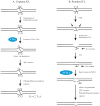Evidence for base excision repair processing of DNA interstrand crosslinks
- PMID: 23219605
- PMCID: PMC3637959
- DOI: 10.1016/j.mrfmmm.2012.11.007
Evidence for base excision repair processing of DNA interstrand crosslinks
Abstract
Many bifunctional alkylating agents and anticancer drugs exert their cytotoxicity by producing cross links between the two complementary strands of DNA, termed interstrand crosslinks (ICLs). This blocks the strand separating processes during DNA replication and transcription, which can lead to cell cycle arrest and apoptosis. Cells use multiple DNA repair systems to eliminate the ICLs. Concerted action of repair proteins involved in Nucleotide Excision Repair and Homologous Recombination pathways are suggested to play a key role in the ICL repair. However, recent studies indicate a possible role for Base Excision Repair (BER) in mediating the cytotoxicity of ICL inducing agents in mammalian cells. Elucidating the mechanism of BER mediated modulation of ICL repair would help in understanding the recognition and removal of ICLs and aid in the development of potential therapeutic agents. In this review, the influence of BER proteins on ICL DNA repair and the possible mechanisms of action are discussed.
Copyright © 2012 Elsevier B.V. All rights reserved.
Conflict of interest statement
None declared
Figures

Similar articles
-
Targeting and processing of site-specific DNA interstrand crosslinks.Environ Mol Mutagen. 2010 Jul;51(6):527-39. doi: 10.1002/em.20557. Environ Mol Mutagen. 2010. PMID: 20196133 Free PMC article. Review.
-
Repair of DNA interstrand cross-links: interactions between homology-dependent and homology-independent pathways.DNA Repair (Amst). 2006 May 10;5(5):566-74. doi: 10.1016/j.dnarep.2006.01.010. Epub 2006 Mar 29. DNA Repair (Amst). 2006. PMID: 16569514
-
Nucleotide excision repair- and polymerase eta-mediated error-prone removal of mitomycin C interstrand cross-links.Mol Cell Biol. 2003 Jan;23(2):754-61. doi: 10.1128/MCB.23.2.754-761.2003. Mol Cell Biol. 2003. PMID: 12509472 Free PMC article.
-
Multiple repair pathways mediate tolerance to chemotherapeutic cross-linking agents in vertebrate cells.Cancer Res. 2005 Dec 15;65(24):11704-11. doi: 10.1158/0008-5472.CAN-05-1214. Cancer Res. 2005. PMID: 16357182
-
Advances in understanding the complex mechanisms of DNA interstrand cross-link repair.Cold Spring Harb Perspect Biol. 2013 Oct 1;5(10):a012732. doi: 10.1101/cshperspect.a012732. Cold Spring Harb Perspect Biol. 2013. PMID: 24086043 Free PMC article. Review.
Cited by
-
Nucleic acid adductomics - The next generation of adductomics towards assessing environmental health risks.Sci Total Environ. 2023 Jan 15;856(Pt 2):159192. doi: 10.1016/j.scitotenv.2022.159192. Epub 2022 Oct 1. Sci Total Environ. 2023. PMID: 36195140 Free PMC article.
-
Role of Base Excision Repair Pathway in the Processing of Complex DNA Damage Generated by Oxidative Stress and Anticancer Drugs.Front Cell Dev Biol. 2021 Jan 22;8:617884. doi: 10.3389/fcell.2020.617884. eCollection 2020. Front Cell Dev Biol. 2021. PMID: 33553154 Free PMC article. Review.
-
DNA Damage Repair: Predictor of Platinum Efficacy in Ovarian Cancer?Biomedicines. 2021 Dec 31;10(1):82. doi: 10.3390/biomedicines10010082. Biomedicines. 2021. PMID: 35052761 Free PMC article. Review.
-
Nucleophosmin modulates stability, activity, and nucleolar accumulation of base excision repair proteins.Mol Biol Cell. 2014 May;25(10):1641-52. doi: 10.1091/mbc.E13-12-0717. Epub 2014 Mar 19. Mol Biol Cell. 2014. PMID: 24648491 Free PMC article.
-
Fanconi anemia-independent DNA inter-strand crosslink repair in eukaryotes.Prog Biophys Mol Biol. 2020 Dec;158:33-46. doi: 10.1016/j.pbiomolbio.2020.08.005. Epub 2020 Aug 30. Prog Biophys Mol Biol. 2020. PMID: 32877700 Free PMC article. Review.
References
-
- Altieri F, Grillo C, Maceroni M, Chichiarelli S. DNA damage and repair: From molecular mechanisms to health implications. Antioxidants & Redox Signaling. 2008;10:891–937. - PubMed
-
- Reddy MC, Vasquez KM. Repair of genome destabilizing lesions. Radiation Research. 2005;164:345–356. - PubMed
-
- Peterson CL, Cote J. Cellular machineries for chromosomal DNA repair. Genes & Development. 2004;18:602–616. - PubMed
Publication types
MeSH terms
Substances
Grants and funding
LinkOut - more resources
Full Text Sources
Other Literature Sources

